Math Carnival: Gathering for Gardner to Show Kids—Math Is Play…and Fun
“It’s flipping the switch. Every time we have this event, kids are like, ‘Wait, this counts as math?’ Because they’re having fun! – Melinda Lanius
January 20, 2017
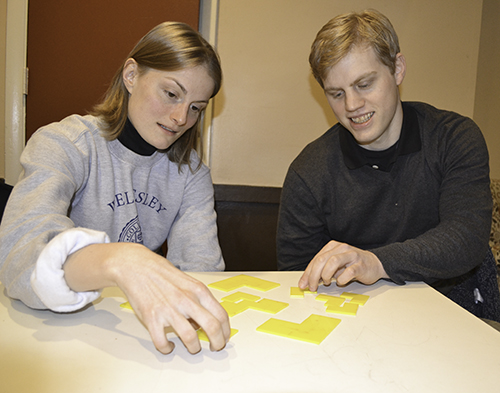 Math Carnival planners Melinda Lanius and Philipp Hieronymi work on a tiles puzzle similar to what will be used in the Tile Emporium activity.
Math Carnival planners Melinda Lanius and Philipp Hieronymi work on a tiles puzzle similar to what will be used in the Tile Emporium activity. The math folks in charge of the 2017 edition of the Math Carnival: Gathering for Gardner have one goal in mind: trying to get kids to realize that math is more than just some dry formulas memorized in school, but it’s a creative, problem-solving process that’s fun. So from 2:00-5:00 pm on Saturday, January 28th, volunteers from the Department of Mathematics, IGL (Illinois Geometry Lab), and Association for Women in Mathematics will be on hand at Altgeld Hall to get the community, especially local kindergarten through middle school youngsters, engaged and playing with math. “That’s the spirit behind this—Math is play!” says Melinda Lanius, a math Ph.D. student who, along with Assistant Professor Philipp Hieronymi, is organizing this year’s event.
The event is named after Martin Gardner, a popular writer known for his mathematical puzzles. According to Gardner, “A puzzle in a sense models what all scientists are doing. They are trying to solve puzzles about the nature of the universe. Puzzles can lead you into almost every branch of mathematics.” So in honor of Gardner, the Math Carnival, the fifth Gathering for Gardner at Illinois, features...puzzles.
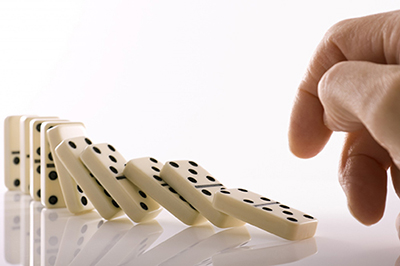 Dominoes illustrate mathematical induction (Image courtesy of SPEAR Education) website.
Dominoes illustrate mathematical induction (Image courtesy of SPEAR Education) website. For example, during Tile Emporium, students will be given a set of tiles and asked to use several to create first a square, then increasingly more complicated shapes using the L shape. According to Lanius, this activity exposes students to mathematical induction, which she explains via a dominoes illustration.
“I want to knock over a line of dominoes," she says, “the first will hit the 2nd, and the 2nd will hit the third, and so on. I first learned this concept in college, and this puzzle really captures this idea. And kids get it—how you use previous smaller squares to make a bigger one.”
 (Image courtesy of Children's Museum of Houston) website.
(Image courtesy of Children's Museum of Houston) website. During Penny Parade, while stacking, sliding, flipping, and arranging pennies, youngsters will “explore game strategy, spatial reasoning, and learn to think outside the box,” according to Lanius.
At Estimation Station, visitors will learn how to estimate quantities. “Humans are terrible at estimating and have terrible number sense,” admits Lanius. So after learning some quick tricks on estimating, participants will then use them to estimate how many pieces are in a jar of candy. Whoever gets closest, wins a prize.
“Cause this is a math carnival," Lanius exclaims, "so there will be prizes!”
 This image illustrates a snowflake's six-pointed rotational symmetry (Image courtesy of the Huffington Post) website.
This image illustrates a snowflake's six-pointed rotational symmetry (Image courtesy of the Huffington Post) website. In another fun hands-on activity, kids will learn about the math behind a snowflake, then create one themselves. “We will talk to them about the symmetry behind snowflakes,” Lanius explains. “Snowflakes have six rotational symmetry and for some reason, all snowflakes want to have this rotational symmetry. And they’re all unique. And depending on what the temperature is or what part of the sky it falls from, the rotational symmetry is different. I look forward to sharing this with the kids.”
Hieronymi appreciates the hands-on approach employed during the Carnival. “That’s something that’s really invaluable. Because mathematics in elementary school is counting or something. Even in middle and high school, it’s numerical methods to solve certain boring problems. Here, it’s truly hands on; you don’t need a calculator or anything.”
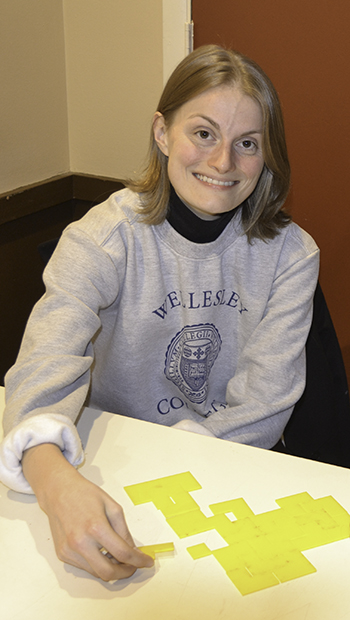 Mathematics Ph.D. student Melinda Lanius
Mathematics Ph.D. student Melinda LaniusTo ensure that mathematicians involved with the event express math concepts in a way that, say, a kindergartener could understand, volunteers will attend training sessions so they can: "Practice our examples," says Lanius. "We have to make sure that we are good with children, you know, because as abstract mathematicians, we usually only explain things to our colleagues."
So, are the kids going to make the connection that these fun puzzles and games are math? Will a little light bulb go off in their heads that says, “Gee, this is math!”
“We’ll tell them that it counts as mathematics, but sometimes it's so far divorced from what they see in school, they may not believe us,” admits Lanius. “It may be years from now that they realize, ‘That was math!’ But really, it counts. It counts!”
Hieronymi likes the idea of exposing kids to the problem-solving mindset of math early on as an alternative to what they get in school.
"When kids see mathematics in school for the very first time, it is numerical; they learn to add and subtract. Even my wife, I think, still has the wrong idea of what we do as mathematicians. So I think it is very important to show early on what math really is. It is a problem solving and understanding phase, and I think this can be done at an earlier age—elementary and middle school."
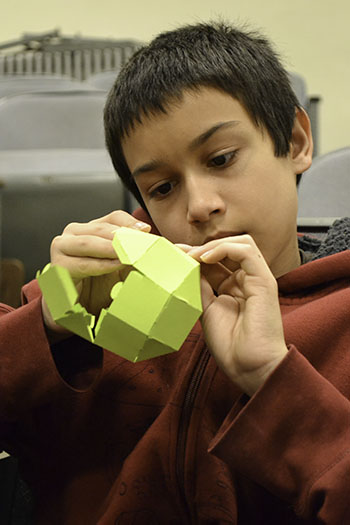 A youngster at a previous Gathering for Gardner folds an Archimedean solid (photo courtesy of Christy Glaze).
A youngster at a previous Gathering for Gardner folds an Archimedean solid (photo courtesy of Christy Glaze).Lanius agrees with Hieronymi that schools don't quite convey to kids what math is:
"In school, when they first are introduced to mathematics, it is quite dry and they’re learning tools that will be useful to be good citizens, but they don’t get a good snapshot of what it is like to be a mathematics researcher. So what we do is take these abstract building blocks, but we are playing around with it. All we really are doing is playing as mathematicians, and it really does have a creative side. So we really want to give children that snapshot, that mathematics is play, and that you can be creative and that this is an avenue of study for you. Math is about playing and learning a way of thinking."
And while the two won’t necessarily immediately see the fruit of their labors, both hope more mathematicians will be added to their ranks down the road, or at least choose STEM careers as a result. And according to Hieronymi, even if only a few of the kids get turned on to math, it’s well worth it.
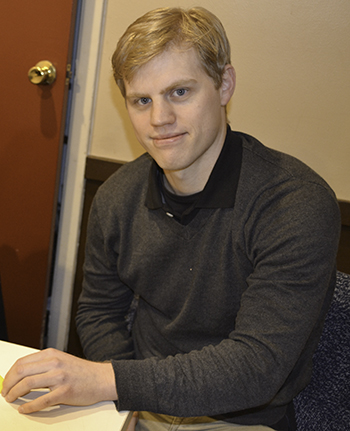 Mathematics Assistant Professor Philipp Hieronymi.
Mathematics Assistant Professor Philipp Hieronymi. “You know, the batting average is pretty low. So if 200 kids come, and if 10 decide they want to do a career in STEM because of this, then this is the best event ever. If you give kids enough opportunities to do these things, and if some of them recognize that this is something that they find interesting, then you get kids to become mathematicians, engineers, scientists.”
According to Lanius, their event could be the catalyst that gets the ball rolling: “It snowballs. One kid finds it very interesting, and they join a board game club at their school, and that actually counts as mathematics. That is game theory. And maybe in high school, they’ll join math club or the robotics team. And hopefully by the time they get to college, they’ll become one of us.”
Why do the two do this event year after year? In addition to the potential of recruiting more kids into STEM, Hieronymi sees holding community events like Math Carnival as a mandate:
"As a public university, I think it’s our responsibility to educate outside our population of students and have something for the outer community. This is a fun event, and it allows us to share our passion with the next generation."
Story and photos by Elizabeth Innes, Communications Specialist, I-STEM Education Initiative.
For additional stories about Math's Gathering for Gardner event, see:
- Local Kids (and Parents) Have Fun with Math at Math Carnival: Gathering for Gardner
- Annual Gathering for Gardner Event Celebrates Recreational Mathematics
For more related stories, see: Association of Women in Mathematics, Champaign-Urbana Community, Open House/Expo, IGL, K-6 Outreach, Math, STEM Pipeline, 2017













.jpg)
















